Do you have a question about the Rheem ECOH200X and is the answer not in the manual?
Covers fire, explosion, and flammable material risks.
Steps to take if you smell gas, including immediate actions and contacting authorities.
Explains safety alert symbols and warning word definitions (Danger, Warning, Caution, Notice).
Warning about chemicals causing cancer or birth defects from the product.
Risks of death, injury, fire, or explosion from improper venting.
Hazards of flammable vapors near the water heater and appliance.
Precautions for vent pipe material and secure connections.
Risks of scalding from water temperatures above 125°F (52°C).
Warnings about applying heat to water connections and pipe insulation.
Specifies acceptable water quality and inlet temperature conditions.
Chart showing burn times at different water temperatures.
Safety concerning gas types, leaks, and LP gas properties.
Conforming to local utility and national codes for gas piping.
Safety precautions for repairs and handling gas supply controls.
Critical safety instructions and warnings before initial operation.
Instructions for detecting gas leaks and immediate actions.
Step-by-step guide for turning on the water heater.
High voltage electrical hazards and safety measures.
Following local and national electrical codes for wiring and grounding.
Warning about chemicals causing cancer or birth defects from the product.
Adhering to installation codes and general safety instructions.
Reading the manual, proper use, and maintenance advice.
Section for recording model, serial, and installation details.
Diagram showing physical dimensions for direct-vent models.
Diagram showing physical dimensions for outdoor models.
Technical data and ratings for 157,000 BTU models.
Technical data and ratings for 199,900 BTU models.
Diagram illustrating components and connections for a direct-vent unit.
Diagram illustrating components and connections for an outdoor unit.
Risks associated with storing or using flammable vapors near the unit.
Guidelines for adjusting the water temperature setting.
Danger of severe burns or death from water temperatures above 125°F (52°C).
Factors affecting water temperature at the faucet, like pipe length.
Key facts about water heater operation, controls, and safety features.
Annual checks for security and airtightness of the venting system.
Handling and checking the condensate drain line for proper function.
Steps for inspecting the main burner flames through the sight glass.
Hazard of electric shock; power must be OFF before cleaning.
Keeping combustible materials away from the water heater.
Step-by-step instructions for cleaning the water filter.
Precautions against deforming or damaging the filter during removal/installation.
Routine maintenance tasks for the user, including filter cleaning and leak checks.
Noticing and responding to periodic relief valve discharge.
Recommended services by qualified technicians for optimal performance.
Dangers of scalding and product damage associated with improper draining.
Precautions when putting the heater back into service after draining.
Alternative procedure for draining the water heater using service valves.
Methods to protect the water heater and piping from freezing conditions.
Using a continuous water flow to prevent freezing.
Warnings regarding draining and turning off power for extended non-use.
Diagnosing and fixing common problems before calling for service.
Safety measure to turn off power before troubleshooting.
Diagnosing and fixing issues related to lack of hot water.
Diagnosing and fixing issues related to excessively hot water.
How the unit displays and indicates error codes on the remote control.
Safety measure to turn off power before accessing error codes.
Table of error codes, possible causes, and solutions.
Information needed when calling for service assistance.
Adherence to national, local, and utility codes for installation.
Guidelines for selecting a proper and safe location for the water heater.
Risks of fire due to flammable materials or improper location.
Minimum distances required from combustible and noncombustible materials.
Areas where the water heater must not be installed, such as garages or occupied rooms.
Checking the unit for damage and ensuring all parts are present.
Warning against installing near air supplies containing halogenated hydrocarbons.
Requirement for a manual gas shut-off valve as per codes.
Visual guide showing the setup for a direct-vent water heater.
Critical warning: This unit is designed for outdoor installation only.
Visual guide showing the setup for an outdoor water heater.
Need for secure wall mounting to prevent injury or damage.
Critical safety risks of incorrect venting, including CO poisoning.
Warnings about required clearances to flammable materials.
Precautions regarding vent recirculation and material.
Table detailing maximum vent pipe lengths based on elbows and diameter.
List of approved vent pipe materials and size requirements.
Recommendations for vent pipe slope, support, and noise reduction.
Procedure for inspecting existing vent systems for replacement installations.
Mandated carbon monoxide detectors for specific installations in MA.
Signage rules for vent terminals in Massachusetts installations.
Minimum distances for vent terminals based on US installation codes.
Minimum distances for vent terminals based on Canadian installation codes.
Risks from flue gas condensate freezing on exterior walls.
Required spacing between vent terminals for multiple indoor units.
Placement advice for outdoor units regarding air inlet and flue outlet.
Hazards of using flammable solvent cements and primers.
List of acceptable vent pipe materials and fittings.
Procedures for properly cementing vent pipe joints.
Types of fasteners recommended for mounting vent pipes to walls.
Required distances between air intake and exhaust vent terminals.
Critical safety risks of incorrect vertical vent installations.
Using only manufacturer-approved termination and parts for vertical venting.
Installing a trap for condensate in the air intake pipe.
Minimum clearance requirements for US vertical vent terminal locations.
Minimum clearance requirements for Canadian vertical vent terminal locations.
Critical conditions for water supply: clean, potable, and within temperature limits.
Requirement for a thermal expansion tank in recirculation systems.
General advice for connecting the water supply to the unit.
Minimum and required water pressures for proper operation and flow.
Procedures for installing shut-off valves and purging water lines.
Ensuring proper connection of water inlet and outlet lines.
Diagram showing piping configuration with service valve kits.
Conditions for safe relief valve function, including pressure and BTUH ratings.
Notes on relief valve types and requirements for discharge piping.
Advantages of insulating water lines for efficiency and freeze protection.
How to properly drain condensate, ensuring it does not freeze.
Dangers of converting the unit between natural gas and LP gas.
Steps for connecting the gas supply line to the water heater.
Method for calculating the correct gas pipe size.
Table providing pipe sizes for natural gas based on length and capacity.
Table providing pipe sizes for propane gas based on length and capacity.
Installing manual gas shut-off valves and unions.
Requirements for gas line material and installation of a sediment trap.
Warnings against open flames for leak testing; use soapy water.
Procedures for pressure testing the gas supply system.
How altitude affects performance and necessary adjustments.
Safety and code requirements for electrical wiring and grounding.
Details on power cords, outlets, and proper grounding.
Factors for choosing where to install the remote control.
Overview of available remote controls and their features.
Safety precautions for wiring the remote control.
How to install the remote control on the wall.
How to connect the remote control cable to the water heater unit.
When and how to use insulation blankets, and warnings about their use.
Key precautions before starting the installation process.
Essential warnings and instructions before attempting to light the unit.
Key safety steps and checks before starting operation.
Step-by-step guide for lighting and starting the water heater.
Steps to safely turn off the water heater.
Dangers of improper temperature settings, including scalding risks.
Importance of reviewing the scald potential chart before adjusting temperature.
Steps to set the water temperature up to 140°F (60°C).
How to stop the temperature display from blinking after adjustment.
Procedure to set a maximum water temperature limit of 120°F (49°C).
Steps to set the minimum water temperature down to 85°F (29°C).
Specific steps for adjusting DIP Switch 2 based on installation altitude.
How to order replacement parts, including required information.
Illustrated diagram of components for direct-vent models.
Illustrated diagram of components for outdoor models.
Covers fire, explosion, and flammable material risks.
Steps to take if you smell gas, including immediate actions and contacting authorities.
Explains safety alert symbols and warning word definitions (Danger, Warning, Caution, Notice).
Warning about chemicals causing cancer or birth defects from the product.
Risks of death, injury, fire, or explosion from improper venting.
Hazards of flammable vapors near the water heater and appliance.
Precautions for vent pipe material and secure connections.
Risks of scalding from water temperatures above 125°F (52°C).
Warnings about applying heat to water connections and pipe insulation.
Specifies acceptable water quality and inlet temperature conditions.
Chart showing burn times at different water temperatures.
Safety concerning gas types, leaks, and LP gas properties.
Conforming to local utility and national codes for gas piping.
Safety precautions for repairs and handling gas supply controls.
Critical safety instructions and warnings before initial operation.
Instructions for detecting gas leaks and immediate actions.
Step-by-step guide for turning on the water heater.
High voltage electrical hazards and safety measures.
Following local and national electrical codes for wiring and grounding.
Warning about chemicals causing cancer or birth defects from the product.
Adhering to installation codes and general safety instructions.
Reading the manual, proper use, and maintenance advice.
Section for recording model, serial, and installation details.
Diagram showing physical dimensions for direct-vent models.
Diagram showing physical dimensions for outdoor models.
Technical data and ratings for 157,000 BTU models.
Technical data and ratings for 199,900 BTU models.
Diagram illustrating components and connections for a direct-vent unit.
Diagram illustrating components and connections for an outdoor unit.
Risks associated with storing or using flammable vapors near the unit.
Guidelines for adjusting the water temperature setting.
Danger of severe burns or death from water temperatures above 125°F (52°C).
Factors affecting water temperature at the faucet, like pipe length.
Key facts about water heater operation, controls, and safety features.
Annual checks for security and airtightness of the venting system.
Handling and checking the condensate drain line for proper function.
Steps for inspecting the main burner flames through the sight glass.
Hazard of electric shock; power must be OFF before cleaning.
Keeping combustible materials away from the water heater.
Step-by-step instructions for cleaning the water filter.
Precautions against deforming or damaging the filter during removal/installation.
Routine maintenance tasks for the user, including filter cleaning and leak checks.
Noticing and responding to periodic relief valve discharge.
Recommended services by qualified technicians for optimal performance.
Dangers of scalding and product damage associated with improper draining.
Precautions when putting the heater back into service after draining.
Alternative procedure for draining the water heater using service valves.
Methods to protect the water heater and piping from freezing conditions.
Using a continuous water flow to prevent freezing.
Warnings regarding draining and turning off power for extended non-use.
Diagnosing and fixing common problems before calling for service.
Safety measure to turn off power before troubleshooting.
Diagnosing and fixing issues related to lack of hot water.
Diagnosing and fixing issues related to excessively hot water.
How the unit displays and indicates error codes on the remote control.
Safety measure to turn off power before accessing error codes.
Table of error codes, possible causes, and solutions.
Information needed when calling for service assistance.
Adherence to national, local, and utility codes for installation.
Guidelines for selecting a proper and safe location for the water heater.
Risks of fire due to flammable materials or improper location.
Minimum distances required from combustible and noncombustible materials.
Areas where the water heater must not be installed, such as garages or occupied rooms.
Checking the unit for damage and ensuring all parts are present.
Warning against installing near air supplies containing halogenated hydrocarbons.
Requirement for a manual gas shut-off valve as per codes.
Visual guide showing the setup for a direct-vent water heater.
Critical warning: This unit is designed for outdoor installation only.
Visual guide showing the setup for an outdoor water heater.
Need for secure wall mounting to prevent injury or damage.
Critical safety risks of incorrect venting, including CO poisoning.
Warnings about required clearances to flammable materials.
Precautions regarding vent recirculation and material.
Table detailing maximum vent pipe lengths based on elbows and diameter.
List of approved vent pipe materials and size requirements.
Recommendations for vent pipe slope, support, and noise reduction.
Procedure for inspecting existing vent systems for replacement installations.
Mandated carbon monoxide detectors for specific installations in MA.
Signage rules for vent terminals in Massachusetts installations.
Minimum distances for vent terminals based on US installation codes.
Minimum distances for vent terminals based on Canadian installation codes.
Risks from flue gas condensate freezing on exterior walls.
Required spacing between vent terminals for multiple indoor units.
Placement advice for outdoor units regarding air inlet and flue outlet.
Hazards of using flammable solvent cements and primers.
List of acceptable vent pipe materials and fittings.
Procedures for properly cementing vent pipe joints.
Types of fasteners recommended for mounting vent pipes to walls.
Required distances between air intake and exhaust vent terminals.
Critical safety risks of incorrect vertical vent installations.
Using only manufacturer-approved termination and parts for vertical venting.
Installing a trap for condensate in the air intake pipe.
Minimum clearance requirements for US vertical vent terminal locations.
Minimum clearance requirements for Canadian vertical vent terminal locations.
Critical conditions for water supply: clean, potable, and within temperature limits.
Requirement for a thermal expansion tank in recirculation systems.
General advice for connecting the water supply to the unit.
Minimum and required water pressures for proper operation and flow.
Procedures for installing shut-off valves and purging water lines.
Ensuring proper connection of water inlet and outlet lines.
Diagram showing piping configuration with service valve kits.
Conditions for safe relief valve function, including pressure and BTUH ratings.
Notes on relief valve types and requirements for discharge piping.
Advantages of insulating water lines for efficiency and freeze protection.
How to properly drain condensate, ensuring it does not freeze.
Dangers of converting the unit between natural gas and LP gas.
Steps for connecting the gas supply line to the water heater.
Method for calculating the correct gas pipe size.
Table providing pipe sizes for natural gas based on length and capacity.
Table providing pipe sizes for propane gas based on length and capacity.
Installing manual gas shut-off valves and unions.
Requirements for gas line material and installation of a sediment trap.
Warnings against open flames for leak testing; use soapy water.
Procedures for pressure testing the gas supply system.
How altitude affects performance and necessary adjustments.
Safety and code requirements for electrical wiring and grounding.
Details on power cords, outlets, and proper grounding.
Factors for choosing where to install the remote control.
Overview of available remote controls and their features.
Safety precautions for wiring the remote control.
How to install the remote control on the wall.
How to connect the remote control cable to the water heater unit.
When and how to use insulation blankets, and warnings about their use.
Key precautions before starting the installation process.
Essential warnings and instructions before attempting to light the unit.
Key safety steps and checks before starting operation.
Step-by-step guide for lighting and starting the water heater.
Steps to safely turn off the water heater.
Dangers of improper temperature settings, including scalding risks.
Importance of reviewing the scald potential chart before adjusting temperature.
Steps to set the water temperature up to 140°F (60°C).
How to stop the temperature display from blinking after adjustment.
Procedure to set a maximum water temperature limit of 120°F (49°C).
Steps to set the minimum water temperature down to 85°F (29°C).
Specific steps for adjusting DIP Switch 2 based on installation altitude.
How to order replacement parts, including required information.
Illustrated diagram of components for direct-vent models.
Illustrated diagram of components for outdoor models.
| Brand | Rheem |
|---|---|
| Model | ECOH200X |
| Category | Water Heater |
| Language | English |

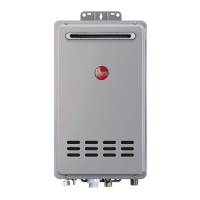



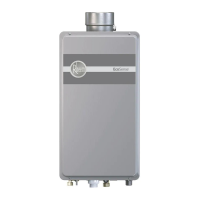
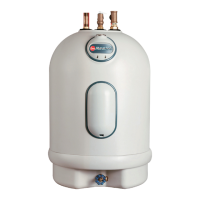
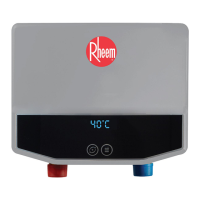



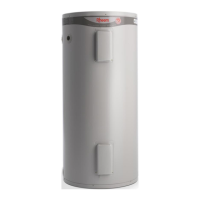
